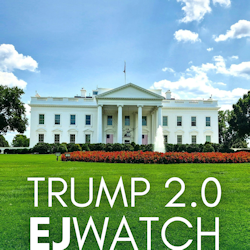SEJournal Online is the digital news magazine of the Society of Environmental Journalists. Learn more about SEJournal Online, including submission, subscription and advertising information.
 |
 |
| Department of Health and Human Services head Robert F. Kennedy Jr. has fired almost all staff on FOIA fulfillment teams at the Centers for Disease Control and Prevention, and other HHS agencies. Photo: CDC (United States government work). |
WatchDog Opinion: Trump 2.0 Cuts Hit FOIA Offices at Federal Agencies
By Joseph A. Davis
Almost lost in the tidal wave of federal staff firings is the damage to the Freedom of Information Act, the program for telling the public what the government is doing.
It’s a key tool for environmental journalists — and it’s threatened. Ask this: What are they trying to hide?
The 1966 FOIA law required most federal agencies to promptly disclose records when requested by members of the public (including journalists), subject to certain exceptions. It has been revised, updated and strengthened over the years.
A significant number of staff are needed
to find the records and fill the requests.
Now those staff are being fired.
But a significant number of staff are needed to find the records and fill the requests. Now those staff are being fired.
How many? We don’t fully know.
Rep. Gerald E. Connolly, D-Va., ranking minority member of the House Oversight Committee, plans to find out and tell the world.
In March, Connolly sent letters to 24 agencies demanding to know what was happening to staff filling FOIA requests. He set an April 3 deadline for response. He has not yet released the results as of publication time.
The agencies Connolly queried include the departments of Energy, Interior, Justice, Labor, Transportation, Agriculture, and Health and Human Services, along with the Environmental Protection Agency and NASA, the National Science Foundation and the Nuclear Regulatory Commission, among others.
DOGE detection
 |
The WatchDog’s concerns are heightened by the secrecy of Trump’s widespread and chaotic firings by Elon Musk’s DOGE entity, which has claimed that its activities are not subject to FOIA.
DOGE stands for Department of Government Efficiency, but any efficiencies from its wrecking-ball actions are hard to find.
But another would-be FOIA rescuer — House Judiciary ranking member Jamie Raskin, D-Md. — joined Connolly in a March 17 letter that was actually a formal FOIA request to DOGE itself. What they asked for was a lot of information about DOGE’s activities.
What we like about it most is that it contained what seemed to be the names of all 40-plus “DOGE kids” terrorizing the agencies. But the main point was that the two Dems were asking for any and all information they could provide that DOGE and its activities were either legal or constitutional.
Good luck with that though. DOGE, remember, has said that it is not subject to FOIA.
From ‘radical transparency’ to layoffs
Let’s look at HHS, now headed by Robert F. Kennedy Jr. When he took office, he declared he would run the department with “radical transparency” (may require subscription).
But by April 1, he was firing almost all staff on FOIA fulfillment teams at the Centers for Disease Control and Prevention, the Food and Drug Administration and the National Institutes of Health. At the same time, many other communications and press office staff at HHS were also laid off.
People’s health depends directly on their
ability to get prompt, accurate information
about health threats they face and what
they can do to protect themselves.
We shouldn’t have to say this — but people’s health depends directly on their ability to get prompt, accurate information about health threats they face and what they can do to protect themselves. We saw examples during the COVID-19 pandemic, which killed an estimated 1.2 million Americans.
This holds for environmental health threats, too.
It raises the question of whether Trump agencies really want to protect public health. Additional evidence: Axios reports that safety hotlines at HHS agencies were also disrupted when HHS laid off staff.
It also raises questions about whether HHS thinks the public knows what’s in its own best interest. For instance, HHS published a notice in the Federal Register on March 3 announcing an end to its 50-year-old policy of asking for public comment on proposed regulations.
And that raises complex questions about exactly what the Administrative Procedure Act does or does not require when it comes to public participation. We will leave this to the lawyers and historians. But apparently, HHS thinks notice and comment is inefficient.
So much for “radical transparency.”
Tracking FOIA performance
In the fog of “transition,” FOIA issues will be obscured. But we can expect them to pop up at other important agencies like the EPA and Interior’s many bureaus.
Further, we can expect that the firings at these agencies are not yet complete or revealed.
But we can track them. That’s because FOIA requires agencies to regularly publish reports on their FOIA performance.
They update them quarterly, although the annual reports are what you really want. The last annual report (through Sept. 30, 2024) says that the EPA had 251.7 full-time equivalent FOIA employees. In the same period, all bureaus at Interior had 132.9.
Now, let’s see how many they have left.
Joseph A. Davis is a freelance writer/editor in Washington, D.C. who has been writing about the environment since 1976. He writes SEJournal Online's TipSheet, Reporter's Toolbox and Issue Backgrounder, and curates SEJ's weekday news headlines service EJToday and @EJTodayNews. Davis also directs SEJ's Freedom of Information Project and writes the WatchDog opinion column.
* From the weekly news magazine SEJournal Online, Vol. 10, No. 15. Content from each new issue of SEJournal Online is available to the public via the SEJournal Online main page. Subscribe to the e-newsletter here. And see past issues of the SEJournal archived here.













 Advertisement
Advertisement 



